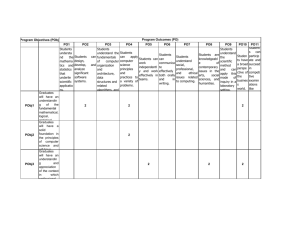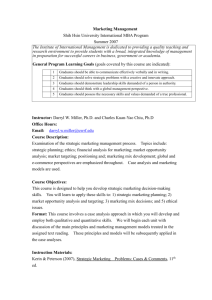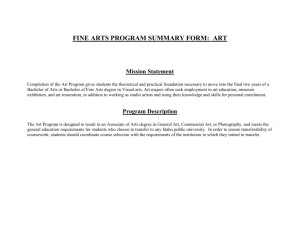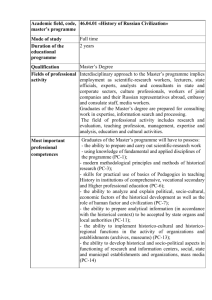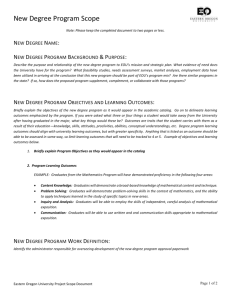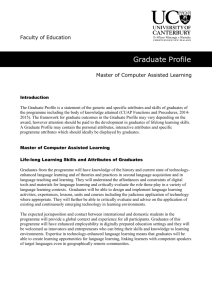May 2013 | In collaboration with Chegg, Inc.
advertisement
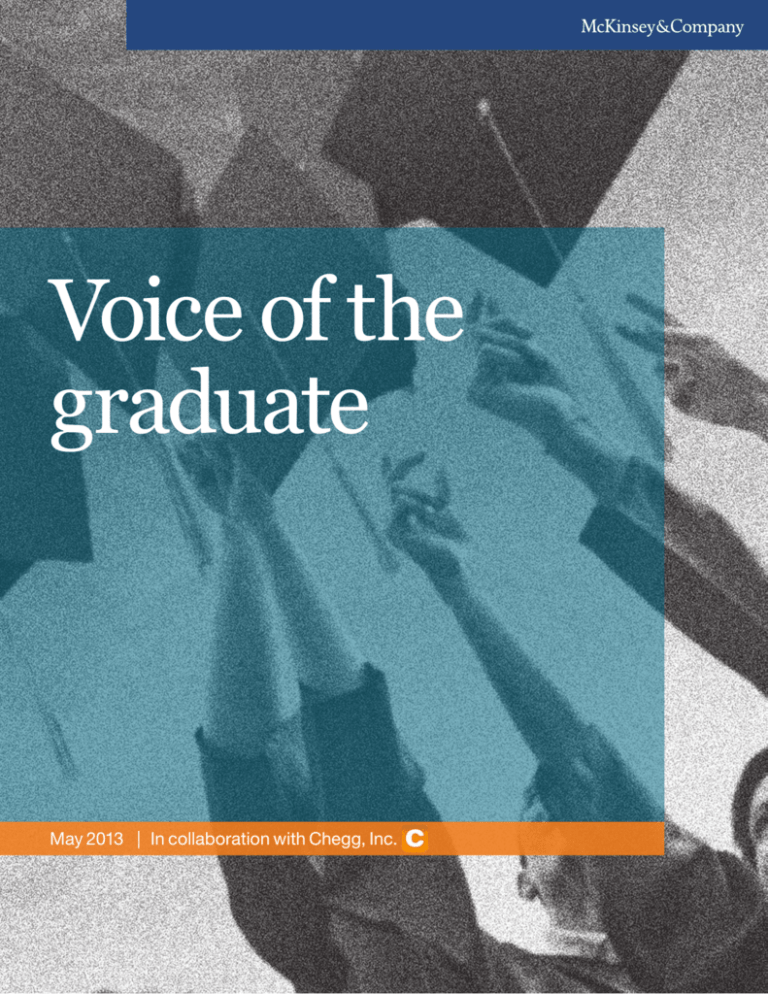
Voice of the graduate May 2013 | In collaboration with Chegg, Inc. 2 Contents Context and executive summary 3 Overqualified6 Underprepared8 Regrets11 Haven’t done the homework 13 Disappointed15 Can I help you? 17 Liberal arts? 19 Do it yourself 21 Conclusion23 3 An important word of context for this report There’s a paradox facing American society today. The demonstrable economic benefit of investing in higher education has never been greater. Research in the United States shows an enduring positive impact on earnings directly associated with the level of postsecondary learning a person attains. And research from around the world shows a link between college education and levels of individual and national well-being more broadly. Yet at the same time, as the survey discussed in this report will show, this potential does not appear to be fully realized in the lived experience of many recent graduates. The gap between higher education’s undeniable value and the concerns many recent graduates nonetheless report should become the impetus for change. In a sense, the “voice of the graduate” revealed in this survey amounts to a cry for help—an urgent call to deepen the relevance of higher education to employment and entrepreneurship so that the promise of higher education is fulfilled. By focusing on the voice of America’s young people, this report, by design, raises more questions than it answers. Our hope is that the underappreciated student perspective can serve as a fresh spur to a conversation that seems overdue. As every thoughtful observer recognizes, the improvements today’s graduates are calling for cannot be pursued by any education stakeholder working alone. Instead, as McKinsey’s work around the world on its “education to employment” initiative suggests, it is only when employers, education providers, public officials, families, and youth advocates work together that effective solutions can be forged. Executive summary Everyone knows education is the path to individual and national prosperity in an era of global competition. Yet US educational attainment, once the envy of the world, has been lagging in recent years—and concerns about the value and efficacy of higher education in particular are making headlines and finding a place on both political parties’ reform agendas. While as recently as 1995 the United States was one of the world leaders in college-graduation rates, the country has since slipped to 12th among industrialized nations. Employers fret that too many college graduates arrive on the job without having acquired the skills and habits to succeed in the workplace. Meanwhile, the rising 4 cost of college and the debt many students and families are expected to incur are raising questions in some quarters about the value of college as an investment, even as critics take aim at the cost structures and traditional practices of colleges and universities in general. Yet while public officials, employers, and educators are heard from frequently in the debate, the voice of students themselves is often missing. To help round out the public understanding of these vital questions, McKinsey partnered with Chegg, a connected learning platform with unusual access to recent graduates, to gauge their attitudes on a range of issues. The survey was conducted in October and November 2012 with more than 4,900 former Chegg customers. The mix included attendees of four-year and two-year private and public colleges, as well as vocational and for-profit institutions. The survey primarily focused on students who graduated between 2009 and 2012, though some students still working toward their degrees were surveyed as well. The data were weighted using standard statistical techniques to assure representativeness by region, gender, and type of institution (details on this are available in the appendix). Our key findings are reviewed in the pages that follow; we also note important questions these student perspectives raise. In a nutshell, although students voice some serious concerns for higher education, they also point to tremendous opportunities. Students largely believe they are overqualified for the jobs they find themselves in after graduation, saying many don’t require a college degree. Many students also feel unprepared for the world of work; the transition from campus to office today is anything but seamless. Half of all graduates express regrets, saying they would pick a different major or school if they had to do it all over again. Students also say that when they were deciding what college to attend, they didn’t consider graduation rates or the job and salary records of graduates. (This echoes findings from McKinsey’s recent report on global “education to employment,” which found that most institutions of higher education don’t track such data systematically in the first place)1. 1 See Dominic Barton, Diana Farrell, and Mona Mourshed, Education to Employment: Designing a System that Works, McKinsey & Company, December 2012 (mckinseyonsociety.com). Voice of the graduate When it came to their transition to work, students felt disappointed—many, even those at top institutions, were unable to find work in their chosen field. For example, assuming that our sample is broadly representative of the nation’s 1.7 million college graduates last year, roughly 120,000 Americans who would rather work elsewhere took jobs as waiters, salespeople, cashiers, and the like. That’s one every five minutes. Liberal-arts and performing-arts graduates tend to be lower paid, deeper in debt, less happily employed, and slightly more likely to wish they’d done things differently. By contrast, those who majored in business management or science, technology, engineering, or mathematics (STEM) fields feel readier for the workplace and more satisfied overall. Finally, in searching for a job, most graduates report using a “do it yourself” approach; the vast majority do not use career services offered by their college or tap into alumni networks to help find a job. These findings may make it appear that the college glass is half empty from the students’ point of view. It is doubtless the case that the nation’s slow recovery from recession helps account for some of the sentiments students express. But while the job market has been tough, it has also fundamentally changed. The types of jobs for which demand is growing are different now than they were 20 years ago, and they increasingly require specialized skills that graduates are not acquiring to a sufficient degree. The good news is that, from the institutions’ point of view, there are enormous opportunities to work with stakeholders to improve student experiences and outcomes—and thus better fulfill the social mission that higher education serves (early thoughts on this “opportunity agenda” appear in the report’s conclusion). By heeding the voice of the students, colleges and universities can take actions that make a real difference. This report will review eight key findings from the research on student attitudes, place these findings in context, and discuss implications. In each case, the report also suggests questions raised by those findings for educators and other stakeholders to consider. The report concludes by sketching the beginnings of an agenda for addressing the concerns that graduates raise. 5 6 Nearly half of graduates from four-year colleges say they are in jobs that don’t require a four-year degree The link between academic preparation and the needs of the 21st-century job market has become a topic of increased interest as the cost of higher education continues to rise, along with student debt. Educators and policy makers want to understand how best to assure that students see their investment in college as relevant for the world of work. In that context, the most striking finding from our survey may be the extent to which recent graduates find themselves in jobs that they say do not require a college degree. Overall, nearly half say this is the case, though graduates of public universities are 11 percent more likely to feel overqualified than those who attended private universities. These student sentiments echo findings from a recent analysis from the US Bureau of Labor Statistics (BLS), which showed that 48 percent of employed US college graduates are in jobs that require less than a four-year college education (indeed, more than 15 percent of taxi drivers and firefighters have a college degree today; only 1 to 2 percent had one in 1970). Perhaps unsurprisingly, fouryear graduates who majored in STEM subjects are most likely to be working in jobs they feel require a four-year degree. But beyond that, the cliché of the overeducated waiter or limousine driver seems to have some support. Voice of the graduate Nearly half of graduates from four-year colleges are in jobs that don’t require a four-year degree. 7 Graduates in STEM subjects are likeliest to be in jobs that require four-year degrees. Questions If, as Labor Department data suggest, the fastest-growing job categories in the United States are those that do not require four-year degrees, do we need to revisit the assumption that everyone should aspire to one? Are there vocational or apprenticeship programs that may be appropriate for larger segments of the student population than we’ve imagined? Is the United States an outlier when it comes to graduates being overqualified for available jobs, or do other advanced nations share this experience? What are the prospects for the economy seeing an upgrade in the skills required for available jobs in the years ahead? Are there ways to better tailor the educational experience to employer needs and student prospects, both as a matter of skill acquisition and cost-effectiveness? 8 About one in three graduates do not feel college prepared them well for the world of work Academic qualifications are one thing; readiness to function in a professional environment is quite another. In working with many of the world’s leading organizations, we’ve noticed A third of graduates of four-year colleges a growing frustration among did not feel college prepared them well for employers with what might employment - it’s worse when you look at be called the “life skills” of two-year colleges. recent graduates. Many employers see these new hires as poorly prepared for life on the job. But how do students themselves perceive things? About one in three graduates of four-year colleges feels their education did not prepare them well for employment. This sentiment is especially pronounced Voice of the graduate Graduates report feeling underprepared in a number of areas. among those who majored in visual and performing arts and liberal arts, though nearly a third of science, business, and economics and finance graduates felt this way as well. And the feeling is widespread for graduates of two-year institutions— particularly for science, marketing and advertising, and visual- or performing-arts majors, 60 to 70 percent of whom feel ill prepared for the workplace. One bright spot concerned the value of work experience during school. Graduates of the top 100 four-year programs2 who gained real work experience (for instance, completing an internship, working part time, or participating in employer mentorship programs) feel better prepared for the workplace. Of those with such work experience, 77 percent say college prepared them well for employment, compared with 59 percent of students who lacked similar experience. 2 Based on U.S. News and World Reports, Best Colleges Rankings, 2013 Edition - National University Rankings and National Liberal Arts College Rankings 9 10 In both 4-year and 2-year colleges, graduates of some majors feel more prepared than others. In general, our findings tracked those of McKinsey’s recent global educationto-employment survey, in which 39 percent of employers said that inadequate training was an issue with new hires. Interestingly, that survey found a sizable perception gap when it came to work readiness: 86 percent of institutions and education providers believe their graduates are adequately prepared for employment, yet only half of employers and graduates agree. Questions Is it a paradox that so many graduates feel overqualified yet also underprepared—or does it suggest that colleges could offer more courses and programs aimed directly at “life skills” needed for success in the workplace? What lessons might be learned from institutions whose graduates report feeling well prepared? Should greater efforts be made to integrate work experience into student life at all institutions? What practical barriers exist to implementing such an idea? What trade-offs would be involved? 11 Half of all graduates would choose a different major or a different school One of the basic measures of the success of any enterprise is the satisfaction of the customers it serves. A straightforward and telling way to gauge this sentiment is to ask whether people would choose the product or service again. So we posed this simple question to students: if you had to do it all over again, what—if anything—would you differently? Their answers were More than half of all graduates would somewhat surprising. do something differently. Across all institutions, more than half of all graduates say they would pick a different major or school—or both— if they were to start over. Graduates of two-year institutions seem to feel the worst about their choice in school; 38 percent would now choose a different one. Yet they are most positive about their choice of major; 12 only 29 percent would make a different choice. In contrast, while graduates of top 100 institutions have fewer regrets about school choice—78 percent would choose the same school again—they are more likely than other graduates of twoand four-year institutions to regret their choice of major. Those most likely to choose a different school if they had the chance are visual- and performing-arts majors (47 percent would choose differently) and health majors (43 percent would make another choice). Some students would choose a different school or major. The students most likely to wish they had majored in something else studied visual and performing arts (41 percent); language, literature, and social sciences (39 percent); and accounting, economics, and finance (39 percent). Health majors were least likely to question their original choice (21 percent). Questions Although some desire for “do-overs” may be inevitable, would greater efforts to educate high-school students about how to judge their potential fit with institutions and fields help reduce regrets? Are there examples of success in this area that could be studied and expanded? To the extent that employability and earnings are a source of regret, is there a risk of losing something important if education is seen merely as a path to a satisfactory job and not as a matter of cultivating citizens with broader perspectives? How should colleges balance these twin aspirations? Would the efforts now under way to publish more data about graduate earnings help students choose fields of study more wisely? 13 Half of graduates didn’t look at graduation rates when picking a college—and four in ten didn’t look at job-placement or salary records Policy makers—including the president, as well as some governors and state legislators— have begun urging (and in some cases requiring) colleges and universities to collect and publish data on such important metrics as graduation rates and graduate job placements and salaries. The thought has been that such transparency would help students make better choices among institutions, while also encouraging institutions to improve their performance. As it turns out, half of the graduates we surveyed didn’t look at graduation rates when picking a college, and four in ten didn’t look at job-placement or salary records. 14 This lack of research is notable because it persists in spite of the huge disparity in graduation rates and the time it takes to graduate (according to the most recent data from the National Center for Higher Education, only about half of students reported graduating within six years). Additionally, there are wide variations in salary prospects, even for graduates of seemingly similar institutions. That said, the norm of students “flying blind” when it comes to these critical metrics may simply be a reflection of the fact that few institutions routinely track and publish such information today. Questions Will current government initiatives to make this data available (via some version of a college “scorecard”) make a difference in student behavior? What would motivate students to consider such information more seriously? Even if such data become reliably available, when do students need to access this information for it to make a difference? Is it needed in high school—and is college therefore too late? If so, what does that imply about the focus of reforms? Should colleges and universities take bolder steps to track and publish such data voluntarily in order to stem the drive for new laws and regulations that may place unreasonable burdens on them and create unintended consequences? Voice of the graduate Section Heading 15 Four in ten graduates of the nation’s top 100 colleges couldn’t get jobs in their chosen field Another lens on the value of higher education for students involves the degree to which college becomes a springboard to enter one’s field of choice. We asked recent graduates if they were able to land jobs in the fields in which they hoped to work. Their answers were startling. Half the nation’s graduates Almost half of all graduates could not get couldn’t find work in the field a job in their desired field. they had hoped to enter— including four in ten of those who graduated from the country’s top schools.1 This disappointment is most acute for language, literature, and social-science majors and for marketing and advertising majors. Health, education, accounting, economics, and finance majors are the likeliest to have found work in the field they intended. Strikingly, even 1 Based on U.S. News and World Reports, Best Colleges Rankings, 2013 Edition - National University Rankings and National Liberal Arts College Rankings 16 Strikingly, even graduates of the nation’s top institutions had trouble finding work in their desired field, with four in ten settling for employment outside their intended area. It may be some consolation for these students that they earn substantially more than their counterparts from less prestigious colleges and are likelier to be in jobs that make use of their degrees. Some graduates were likelier to find work in their desired field. Graduates from top 100 four-year institutions report earning more and to more likely be in jobs that require a four-year degree or more. Questions Are there better ways to educate high-school students about potential opportunities in different fields so that they develop more realistic expectations about their chances for employment? Does the scale of unmet expectations suggest that colleges need to improve their careercounseling functions? How? Are there effective examples of such efforts that might serve as models? 17 Almost six times as many graduates are working in retail or hospitality as originally desired to When we looked more deeply into the fields students hoped to enter and those in which they ended up finding employment, a pattern emerged. The retail and restaurant industries were among the least desired fields for students entering or attending school, but they end up employing four to five times the number of graduates who said they Significantly more graduates work in retail wanted to work in those or hospitality than originally planned to. sectors. Assuming our sample is broadly representative of the 1.7 million US graduates who earned bachelor’s degrees this year, this means roughly 120,000 young Americans who’d rather work elsewhere have taken jobs as waiters, salespeople, cashiers, and the like—because that’s the only work they could find. 18 Health and business services have the biggest gap between desired and actual employment. That’s one every five minutes. Digging a bit deeper, the most popular fields of choice were health and business services; nearly 35 percent of students surveyed wanted to enter these fields, though only 25 percent found work in them. A great many ended up in retail and restaurants instead. These trends seem broadly consistent with what the BLS has found in its surveys—namely, that 10 percent of cashiers, 15 percent of waiters and waitresses, and 25 percent of retail salespeople have a college degree. Questions Do retail and restaurant jobs end up being dead-end jobs for recent graduates, or are they the “first rung on the ladder” on which most build? If retail and restaurant jobs are destined to be fast-growing categories of work, are there ways to rethink the value proposition of these jobs so that more graduates feel happier choosing them? 19 Liberal-arts graduates fare worse than average in all measures A debate has emerged in recent years about whether American higher education has become too directly focused on one’s career; business majors now account for a sizable portion of graduates, and liberal-arts majors may feel less valued in the workplace. While the intrinsic value of liberal arts cannot be Liberal-arts majors fared worse than average disputed, the results of in all measures. our survey revealed more ambiguity with respect to student outcomes. Graduates who majored in liberal arts and performing arts at four-year colleges fare the worst across every measure: they tend to be lower paid, deeper in debt, less happily employed, and slightly more likely to wish they’d done things differently. 20 Graduates in certain disciplines did relatively well. These statistics also hold true for graduates of twoyear institutions. In contrast, graduates of four-year programs who majored in business management and STEM disciplines were above average on most measures of employment readiness and satisfaction. They report being better prepared for employment, and they’re more likely to be in a job that required their four-year degree, as well as more likely to have an above-average income; if given the choice, these graduates would likely choose the same major. The BLS similarly showed that engineering and economics majors tend to earn more than graduates of other disciplines by the midpoint of their career. Questions How can we better support liberal-arts graduates in finding jobs they want? Could better apprenticeship or mentorship programs make a difference? Will we be able to attract sufficient young talent to the arts and humanities given these trends? What might change these outcomes? How might educational institutions and stakeholders galvanize new efforts so that the many benefits of a liberal-arts education do not come at the expense of employment prospects? 21 Less than 40 percent of graduates used career services and less than 30 percent tapped into alumni networks to find a job Despite much talk in recent years of improving the way colleges help students find jobs, students mostly report feeling they were on their own. Most graduates relied on personal networks, not institutional mechanisms, to find jobs. Across both top four-year institutions and other four-year institutions, students most often used their personal network to find jobs rather than take advantage of the resources offered at their colleges or through alumni networks. Students at top four-year institutions find their careerservices office and alumni networks 1.5 times more helpful than graduates of other institutions do. 22 They did, however, have ideas for ways their experience could be improved: 23 percent of students across all types of institutions say their college could have better prepared them for employment with better job-placement and career services; 18 percent say real experience would be valuable, and 13 percent ask for more practical skills development in class. Graduates look for job-placement assistance, experience, and practical skills. Questions What steps can colleges take to improve their career services? Are there best practices that top institutions could share, or does the entire sector need to upgrade this function? What role might life-skills programs play in improving the transition from college to employment? Voice of the graduate Conclusion Graduates are raising serious questions about how effectively some colleges function as a bridge between high school and the workplace. But these concerns also reveal an enormous opportunity for educators, leaders, and other stakeholders to respond. What might an “opportunity agenda” in this terrain look like? First, as recent graduates make plain, colleges can better link campus life to the world of work. This may involve more rigorous efforts to assure that experiential learning is part of every student’s education, from internships to co-op work to meaningful volunteering and more. Schools could also offer modules on workplace skills that give students an essential grounding in how to function effectively in professional environments. Capturing the opportunity also includes what might be thought of as an “informational” agenda. Educational institutions, from high schools on up, could better inform students about employment and income trends in different fields. Additionally, colleges might get ahead of government efforts to require more transparency on graduation rates, job placement, and salaries by developing their own initiatives to this end—which could include training families and students to use the information constructively. Education leaders could also work together to develop meaningful alternative paths for students who might not fully benefit from a four-year degree. They could study successful efforts in other countries and look at the practices of US institutions that that have improved student satisfaction and placement prospects. It’s clear in listening to recent graduates that there is no shortage of work to be done to help higher education reach its full promise in an era of accelerating change. We hope this report contributes to the ongoing dialogue among educators, policy makers, and other stakeholders on how to fulfill higher education’s vital mission in the years ahead. 23 24 Who we surveyed: A summary of the demographics. Voice of the graduate Our methodology for weighting the data. 25 Voice of the graduate May 2013 Designed by the U.S. Design Center Copyright © McKinsey & Company www.mckinsey.com



